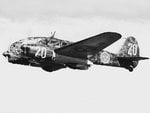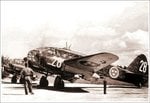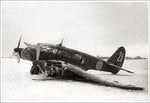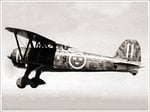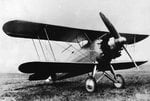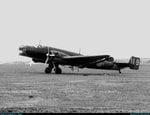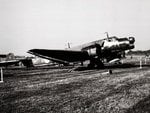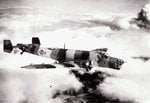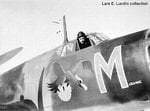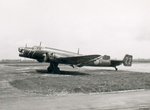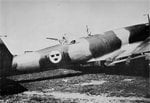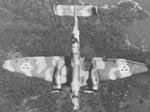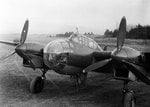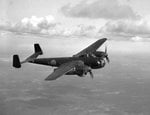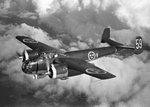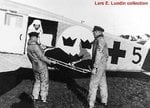Swedish military aviation was born with the introduction to the Army of balloon observation during the late 1800s, and the first powered military aircraft were introduced around 1910. Sweden, originally operating a Navy and Army aviation corps, joined them to form the Royal Swedish Air Force (RSAF) in 1926. Between the end of WWII and the first half of the 1950s, the Royal Swedish Air Force had developed into an air force ranked among the world's largest and best equipped. As a result of Germany's attack on Poland on September 1, 1939, Sweden declared itself neutral – just as it did in 1914. The Swedish Prime Minister assured the Swedish people that "…our preparedness is good" – but regarding the Air Force, the air territory of Sweden, stretching 1572 km (975 miles) from north to south and 499 km (310 miles) from east to west, was to be defended by means of a total force of 40 medium bombers (mainly Junkers Ju86s), 30 light bombers (mainly Hawker Harts), 50 fighters (mainly Gloster Gladiators), 50 reconnaissance planes (mainly Fokker C.V.E.s) and 10 torpedo planes – making a total of 180 aircraft… However, despite the lack of equipment, the flying personnel were well-trained and of high quality by international standards; also the introduced system of geographically dispersed "war air bases" all over Sweden gave room for a highly flexible air force.
When Finland was invaded by the Soviet Union in November of 1939, Sweden declared itself "non-belligerent" instead of "neutral" in the Finno-Russian war, as feelings for the sister country were strong as a result of hundreds of years of common history. The national efforts to help the Finnish people, under the motto "Finland's cause is our cause!", were mostly of a civilian character, but many Swedish volunteers fought side by side with the Finns against the Russians, and infantry weapons were shipped over the Baltic Sea. Moreover, eight aircraft were initially donated to the Finnish Air Force, and support in the form of a flight wing was organised and made operational. RSAF air wings, "flottiljer", of that time, fully operational as well as planned, were numbered "F 1" to "F 18", and the voluntary wing sent to Finland was called the F 19 Wing. The wing was put under Finnish command, and consisted of twelve fighters (Gloster Gladiators), eight light bombers (Hawker Harts), three transport aircraft and 250 air force volunteers. In January of 1940, the F 19 wing was fully operational (as "Flight Regiment 5" in the Finnish war organisation). Until the armistice of what was called "the Finnish winter war", the Swedish Wing fought well against the Soviet Air Force, and the air crews' experiences provided valuable input for the further development of the Royal Swedish Air Force. Sweden imported some 200 fighters from Italy and the USA. The Swedish wood-and-metal fighter FFVS J 22 (constructed and built during the war, first flown in 1942), together with the dive-bomber SAAB 17 (first flown in 1940) and the medium bomber SAAB 18 (first flown in 1942) were all successful Swedish-built military aircraft of WWII. Thus, the Swedish neutrality watch was undergoing heavy progress during the war and the Swedish air defences were eventually a powerful force to defend Sweden from any possible hostilities. In terms of aeronautical technology, the Swedish aircraft industry was well-ahead regarding new inventions: the nose-geared, push-engine J21 fighter (first flown in 1943) necessitated the development of one of the first jet-driven ejection seats in operational use.
Even though Sweden never took actual part in the hostilities, the Swedish Air Force saw combat in terms of defending neutrality and guiding straying Allied and German aircraft to safe landing grounds. In this role, the RSAF proved especially useful in the southern parts of Sweden during the last years of the war, when Allied bombing routes were drawn increasingly closer to Swedish air territory. It is worth noting that no less than a total of 342 foreign military aircraft landed in Sweden during WWII, of which about 200 were American or British aircraft with varying degrees of battle-damage. To many Allied air crew in crippled Lancasters, B-17s and B-24s, Sweden provided a "haven of refuge" instead of ditching at sea or in German-occupied countries, although the air crews were detained in Sweden. There were special internment camps built and/or organised (Allied and German soldiers were kept in separate places), and although run by Swedish military personnel, the conditions were in many cases more like a spa than those of an imprisonment camp. At the end of the war, the strength of the Swedish Air Force had changed drastically from its status of 1939: in 1945 it had over 800 aircraft ready to pursue a combat role, including 15 fighter divisions (200 aircraft, of which the most modern were the newly acquired P-51s); 3 long-range reconnaissance divisions (30 aircraft); 5 short-range reconnaissance divisions (50 aircraft), and 6 naval reconnaissance divisions (40 aircraft). Among the most frequently used combat aircraft in the Swedish Air Force during WW2 were the following: Fighters: Gloster Gladiator (J8), Seversky Republic EP-1 (J9), Fiat CR42 (J11), Reggiane 2000 Falco (J20), SAAB 21 (J21), FFVS J 22 (J22), NA P-51 Mustang (J26); Bombers: Junkers Ju86 K (B3), Hawker Hart (B4), Northrop 8 A-1 (B5), Caproni Ca313 (B16), SAAB 17 (B17), SAAB 18 (B18); Torpedo aircraft: Heinkel He115 A2 (T2), Junkers Ju86 K (T3), Caproni Ca313 (T16); Reconnaissance aircraft: Heinkel He114 (S12), Fokker C.V.E. (S6), Hawker Osprey (S9), Fieseler Fi156 Storch (S14).
Even though the separate aviation units of the Army and the Navy were united in the Swedish Air Force in 1926, the combat roles of Army-related liaison and reconnaissance aviation as well as Naval reconnaissance and sea rescue continued to be executed by flight units closely affiliated with the Army and the Navy respectively. In 1939, a Royal Swedish Air Force wing, the F 3 wing, was assigned to perform army reconnaissance duties, using Fokker (S6), Fieseler Storch (S14), and later also Junkers Ju86 (B3), Handley Page Hampden (P5), Caproni Ca313 (S16) and SAAB 17 (S17). The RSAF F 2 wing served as a liaison unit with the Swedish Navy, operating in torpedo attack, reconnaissance and sea rescue roles, flying aircraft such as the Heinkel He114 (S12), Fokker C.V.E. (S6), Hawker Osprey (S9), Junkers W34 (Tp2), SAAB 17 (S17) and the (formerly German Luftwaffe) Dornier Do24 (Tp24).
When Finland was invaded by the Soviet Union in November of 1939, Sweden declared itself "non-belligerent" instead of "neutral" in the Finno-Russian war, as feelings for the sister country were strong as a result of hundreds of years of common history. The national efforts to help the Finnish people, under the motto "Finland's cause is our cause!", were mostly of a civilian character, but many Swedish volunteers fought side by side with the Finns against the Russians, and infantry weapons were shipped over the Baltic Sea. Moreover, eight aircraft were initially donated to the Finnish Air Force, and support in the form of a flight wing was organised and made operational. RSAF air wings, "flottiljer", of that time, fully operational as well as planned, were numbered "F 1" to "F 18", and the voluntary wing sent to Finland was called the F 19 Wing. The wing was put under Finnish command, and consisted of twelve fighters (Gloster Gladiators), eight light bombers (Hawker Harts), three transport aircraft and 250 air force volunteers. In January of 1940, the F 19 wing was fully operational (as "Flight Regiment 5" in the Finnish war organisation). Until the armistice of what was called "the Finnish winter war", the Swedish Wing fought well against the Soviet Air Force, and the air crews' experiences provided valuable input for the further development of the Royal Swedish Air Force. Sweden imported some 200 fighters from Italy and the USA. The Swedish wood-and-metal fighter FFVS J 22 (constructed and built during the war, first flown in 1942), together with the dive-bomber SAAB 17 (first flown in 1940) and the medium bomber SAAB 18 (first flown in 1942) were all successful Swedish-built military aircraft of WWII. Thus, the Swedish neutrality watch was undergoing heavy progress during the war and the Swedish air defences were eventually a powerful force to defend Sweden from any possible hostilities. In terms of aeronautical technology, the Swedish aircraft industry was well-ahead regarding new inventions: the nose-geared, push-engine J21 fighter (first flown in 1943) necessitated the development of one of the first jet-driven ejection seats in operational use.
Even though Sweden never took actual part in the hostilities, the Swedish Air Force saw combat in terms of defending neutrality and guiding straying Allied and German aircraft to safe landing grounds. In this role, the RSAF proved especially useful in the southern parts of Sweden during the last years of the war, when Allied bombing routes were drawn increasingly closer to Swedish air territory. It is worth noting that no less than a total of 342 foreign military aircraft landed in Sweden during WWII, of which about 200 were American or British aircraft with varying degrees of battle-damage. To many Allied air crew in crippled Lancasters, B-17s and B-24s, Sweden provided a "haven of refuge" instead of ditching at sea or in German-occupied countries, although the air crews were detained in Sweden. There were special internment camps built and/or organised (Allied and German soldiers were kept in separate places), and although run by Swedish military personnel, the conditions were in many cases more like a spa than those of an imprisonment camp. At the end of the war, the strength of the Swedish Air Force had changed drastically from its status of 1939: in 1945 it had over 800 aircraft ready to pursue a combat role, including 15 fighter divisions (200 aircraft, of which the most modern were the newly acquired P-51s); 3 long-range reconnaissance divisions (30 aircraft); 5 short-range reconnaissance divisions (50 aircraft), and 6 naval reconnaissance divisions (40 aircraft). Among the most frequently used combat aircraft in the Swedish Air Force during WW2 were the following: Fighters: Gloster Gladiator (J8), Seversky Republic EP-1 (J9), Fiat CR42 (J11), Reggiane 2000 Falco (J20), SAAB 21 (J21), FFVS J 22 (J22), NA P-51 Mustang (J26); Bombers: Junkers Ju86 K (B3), Hawker Hart (B4), Northrop 8 A-1 (B5), Caproni Ca313 (B16), SAAB 17 (B17), SAAB 18 (B18); Torpedo aircraft: Heinkel He115 A2 (T2), Junkers Ju86 K (T3), Caproni Ca313 (T16); Reconnaissance aircraft: Heinkel He114 (S12), Fokker C.V.E. (S6), Hawker Osprey (S9), Fieseler Fi156 Storch (S14).
Army and Navy Aviation
Even though the separate aviation units of the Army and the Navy were united in the Swedish Air Force in 1926, the combat roles of Army-related liaison and reconnaissance aviation as well as Naval reconnaissance and sea rescue continued to be executed by flight units closely affiliated with the Army and the Navy respectively. In 1939, a Royal Swedish Air Force wing, the F 3 wing, was assigned to perform army reconnaissance duties, using Fokker (S6), Fieseler Storch (S14), and later also Junkers Ju86 (B3), Handley Page Hampden (P5), Caproni Ca313 (S16) and SAAB 17 (S17). The RSAF F 2 wing served as a liaison unit with the Swedish Navy, operating in torpedo attack, reconnaissance and sea rescue roles, flying aircraft such as the Heinkel He114 (S12), Fokker C.V.E. (S6), Hawker Osprey (S9), Junkers W34 (Tp2), SAAB 17 (S17) and the (formerly German Luftwaffe) Dornier Do24 (Tp24).

